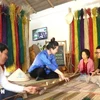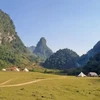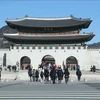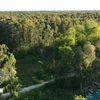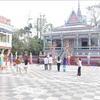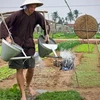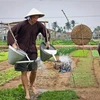 Setting foot in this ancient village of Y Ty commune in Bat Xat district, Lao Cai province, visitors will be attracted for not only unique rammed earth houses here but also the innocent smiles and eyes of Ha Nhi ethnic children. Ha Nhi is one of the 54 ethnic groups in Vietnam and, according to the 2009 population census, has a population of about 22,000. Most of this minority group’s population live in Lao Cai, Lai Chau and Dien Bien, three mountainous border provinces in the north of the country. They gather in villages with about 50 – 60 households each and farm wet rice, crops and livestock as the main livelihoods (Photo: VietnamPlus)
Setting foot in this ancient village of Y Ty commune in Bat Xat district, Lao Cai province, visitors will be attracted for not only unique rammed earth houses here but also the innocent smiles and eyes of Ha Nhi ethnic children. Ha Nhi is one of the 54 ethnic groups in Vietnam and, according to the 2009 population census, has a population of about 22,000. Most of this minority group’s population live in Lao Cai, Lai Chau and Dien Bien, three mountainous border provinces in the north of the country. They gather in villages with about 50 – 60 households each and farm wet rice, crops and livestock as the main livelihoods (Photo: VietnamPlus)  Wild flowers are popular toys of children here. Ha Nhi people often reside in valleys below halfway up the mountain. In the Ha Nhi community, women are the breadwinners in families so they are in charge of farm work while men and the elderly often do the housework. The Ha Nhi language belongs to the Tibeto – Burmese language group. This ethnic group lives on rice cultivation of burnt-over land or terraced fields. They are one of the groups experienced in reclaiming terraced fields on mountain slopes, digging canals and building small dams. Their animal husbandry, weaving and basketry making are also developed (Photo: VietnamPlus)
Wild flowers are popular toys of children here. Ha Nhi people often reside in valleys below halfway up the mountain. In the Ha Nhi community, women are the breadwinners in families so they are in charge of farm work while men and the elderly often do the housework. The Ha Nhi language belongs to the Tibeto – Burmese language group. This ethnic group lives on rice cultivation of burnt-over land or terraced fields. They are one of the groups experienced in reclaiming terraced fields on mountain slopes, digging canals and building small dams. Their animal husbandry, weaving and basketry making are also developed (Photo: VietnamPlus)  After school, children in Choan Then gather and move around the village to play. Y Ty in Bat Xat district, about 70 km to the north of renowned resort town Sa Pa, is rather isolated due to high surrounding mountains. It is famed among Vietnamese trekkers for its beautiful scenery at cloud level. The commune, which is 2,000 metres above sea level, is home to H’mong, Dao, Giay and Ha Nhi ethnic minority groups. Y Ty is beautiful throughout the year, though September and October are considered the best months to visit as the paddies will turn yellow dotted with houses with wooden roofs (Photo: VietnamPlus)
After school, children in Choan Then gather and move around the village to play. Y Ty in Bat Xat district, about 70 km to the north of renowned resort town Sa Pa, is rather isolated due to high surrounding mountains. It is famed among Vietnamese trekkers for its beautiful scenery at cloud level. The commune, which is 2,000 metres above sea level, is home to H’mong, Dao, Giay and Ha Nhi ethnic minority groups. Y Ty is beautiful throughout the year, though September and October are considered the best months to visit as the paddies will turn yellow dotted with houses with wooden roofs (Photo: VietnamPlus)  Young girls enjoy a snack together. Y Ty has become an appealing destination for local and international tourists thanks to its beautiful paddy fields and traditional forest-worship rituals. About 80 kilometres north of Lao Cai city, this commune is made up of mountainous terrain with steep slopes and a tough climate, with many streams that make it difficult for locals to farm any grain variety. To adapt, locals created terraced paddy fields, with each generation expanding them, one on top of the other hugging mountains. At 2,000 metres above sea level and wrapped in mist and clouds, the terraced paddy fields impress visitors with a beautiful view of where sky meets earth (Photo: VietnamPlus)
Young girls enjoy a snack together. Y Ty has become an appealing destination for local and international tourists thanks to its beautiful paddy fields and traditional forest-worship rituals. About 80 kilometres north of Lao Cai city, this commune is made up of mountainous terrain with steep slopes and a tough climate, with many streams that make it difficult for locals to farm any grain variety. To adapt, locals created terraced paddy fields, with each generation expanding them, one on top of the other hugging mountains. At 2,000 metres above sea level and wrapped in mist and clouds, the terraced paddy fields impress visitors with a beautiful view of where sky meets earth (Photo: VietnamPlus)  Girls often gather in their own group while boys only play with their male peers. Here in Y Ty, the area is covered by clouds clinging to the side of mountains in winter, looking like a heaven of fairies. The white colour is replaced by the pink of the Do Quyen (rhododendron) flower in full bloom in spring. As summer comes, the grey paddy fields seem to be covered in a new cloth by the skillful and industrious hands of locals. In September and October, Y Ty commune is the most beautiful as the paddies turn yellow dotted with houses with wooden roofs (Photo: VietnamPlus)
Girls often gather in their own group while boys only play with their male peers. Here in Y Ty, the area is covered by clouds clinging to the side of mountains in winter, looking like a heaven of fairies. The white colour is replaced by the pink of the Do Quyen (rhododendron) flower in full bloom in spring. As summer comes, the grey paddy fields seem to be covered in a new cloth by the skillful and industrious hands of locals. In September and October, Y Ty commune is the most beautiful as the paddies turn yellow dotted with houses with wooden roofs (Photo: VietnamPlus) 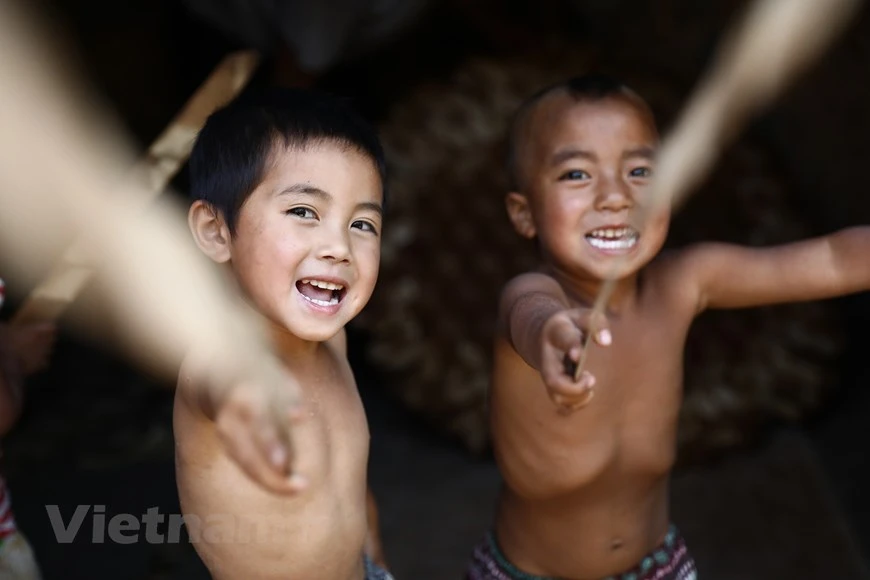 Boys in Choan Then village play a sword fighting game. To have the best view of Y Ty’s cloud-covered region, it is recommended to travel from September to the following April during the dry season, with a possibility of snow. In early April, tourists will also be welcomed by blooming rhododendron trees, covering the region with a pink-violet shade. In May and June when summer rains begin, water flows to the fields, softening dry soil to allow locals to begin planting rice. The brown soil, sparkling water, sun rays and green rice seedlings all create a wondrous picture for tourists. From late August to October, visitors can experience the blooming golden terraced rice fields (Photo: VietnamPlus)
Boys in Choan Then village play a sword fighting game. To have the best view of Y Ty’s cloud-covered region, it is recommended to travel from September to the following April during the dry season, with a possibility of snow. In early April, tourists will also be welcomed by blooming rhododendron trees, covering the region with a pink-violet shade. In May and June when summer rains begin, water flows to the fields, softening dry soil to allow locals to begin planting rice. The brown soil, sparkling water, sun rays and green rice seedlings all create a wondrous picture for tourists. From late August to October, visitors can experience the blooming golden terraced rice fields (Photo: VietnamPlus)  Technology has reached this rural area. Many adults busy with farm work leave their children home with a smartphone to play. Y Ty commune of Lao Cai province is famed among Vietnamese trekkers for its beautiful scenery at cloud level. It was once selected as one of the Best-kept Secrets in Asia Travel by the travel site www.thrillist.com, which said: ‘Y Ty sits atop Vietnam’s highest plateau, offering spectacular views of cloud-reaching mountains and yellow rice patty fields. If you want to experience rural Vietnam without straying far from the tourist centre of Sa Pa, this is your spot.’ This website also suggested tourists get to know locals at Y Ty’s market ‘where surrounding ethnic tribes sell traditional crafts and agricultural goods’ (Photo: VietnamPlus)
Technology has reached this rural area. Many adults busy with farm work leave their children home with a smartphone to play. Y Ty commune of Lao Cai province is famed among Vietnamese trekkers for its beautiful scenery at cloud level. It was once selected as one of the Best-kept Secrets in Asia Travel by the travel site www.thrillist.com, which said: ‘Y Ty sits atop Vietnam’s highest plateau, offering spectacular views of cloud-reaching mountains and yellow rice patty fields. If you want to experience rural Vietnam without straying far from the tourist centre of Sa Pa, this is your spot.’ This website also suggested tourists get to know locals at Y Ty’s market ‘where surrounding ethnic tribes sell traditional crafts and agricultural goods’ (Photo: VietnamPlus)  Each of the several tens of households here has at least two or three children, or even five or six, who are all lovely and unaffected. Choan Then is among the places where old rammed earth houses with thatch roofs still exist today. These houses are called ‘nha trinh tuong’, with 'nha' being house and 'tuong' being wall. 'Trinh' is derived from the word 'chinh', which means ‘pounded until firm’ in the language of local ethnic minorities. The walls made of earth have stood the test of time and fierce weather conditions and keep their owners warm in winter and cool in summer (Photo: VietnamPlus)
Each of the several tens of households here has at least two or three children, or even five or six, who are all lovely and unaffected. Choan Then is among the places where old rammed earth houses with thatch roofs still exist today. These houses are called ‘nha trinh tuong’, with 'nha' being house and 'tuong' being wall. 'Trinh' is derived from the word 'chinh', which means ‘pounded until firm’ in the language of local ethnic minorities. The walls made of earth have stood the test of time and fierce weather conditions and keep their owners warm in winter and cool in summer (Photo: VietnamPlus)  Choan Then still has its pristine beauty preserved nowadays. Surrounding this village are beautiful landscapes like Y Ty Forest, Lao Chai village, Lao Than Mountain, Y Ty Market, the The Pa terraced rice fields – a national landscape and Thien Sinh Bridge. Here, ‘trinh tuong’ houses are an identity of this village. While rammed earth houses are popular in Vietnam’s northern region, the houses of Ha Nhi people are square-shaped with their roofs tiled with thatch. The Ha Nhi people have always been known to be diligent. Apart from growing wet rice on terraced fields for self-sufficiency they also grow cotton and weave fabric to make traditional costumes of their ethnic group (Photo: VietnamPlus)
Choan Then still has its pristine beauty preserved nowadays. Surrounding this village are beautiful landscapes like Y Ty Forest, Lao Chai village, Lao Than Mountain, Y Ty Market, the The Pa terraced rice fields – a national landscape and Thien Sinh Bridge. Here, ‘trinh tuong’ houses are an identity of this village. While rammed earth houses are popular in Vietnam’s northern region, the houses of Ha Nhi people are square-shaped with their roofs tiled with thatch. The Ha Nhi people have always been known to be diligent. Apart from growing wet rice on terraced fields for self-sufficiency they also grow cotton and weave fabric to make traditional costumes of their ethnic group (Photo: VietnamPlus)  According to the Lao Cai provincial Department of Culture, Sports and Tourism, a number of special cultural identities of the Ha Nhi ethnic group are still preserved in Choan Then village at present such as rammed earth houses, costumes, food, festivals, and traditional folk games. ‘Trinh truong’ houses here are similar to one another in terms of form, structure, space planning and decoration. Each house often covers an area of 60 – 80 square metres, and the wall is 40 – 60 centimetres in thickness and 4 – 5 metres in height. The building of ‘trinh tuong’ houses starts at the end of the harvest season, from the eighth to the twelfth lunar month (Photo: VietnamPlus)
According to the Lao Cai provincial Department of Culture, Sports and Tourism, a number of special cultural identities of the Ha Nhi ethnic group are still preserved in Choan Then village at present such as rammed earth houses, costumes, food, festivals, and traditional folk games. ‘Trinh truong’ houses here are similar to one another in terms of form, structure, space planning and decoration. Each house often covers an area of 60 – 80 square metres, and the wall is 40 – 60 centimetres in thickness and 4 – 5 metres in height. The building of ‘trinh tuong’ houses starts at the end of the harvest season, from the eighth to the twelfth lunar month (Photo: VietnamPlus)  ‘Cong vien Y Ty’ (Y Ty Park) is what locals and many visitors call the area located at the end of the road traversing Choan Then village. This place features a thatched hut in the shade of two big trees and a large vacant land below which are terraced rice fields. Y Ty commune is famed among Vietnamese trekkers for its beautiful scenery at cloud level. It was once selected as one of the Best-kept Secrets in Asia Travel by the travel site www.thrillist.com. To have the best view of Y Ty’s cloud-covered region, it is recommended to travel from September to the following April during the dry season, with a possibility of snow (Photo: VietnamPlus)
‘Cong vien Y Ty’ (Y Ty Park) is what locals and many visitors call the area located at the end of the road traversing Choan Then village. This place features a thatched hut in the shade of two big trees and a large vacant land below which are terraced rice fields. Y Ty commune is famed among Vietnamese trekkers for its beautiful scenery at cloud level. It was once selected as one of the Best-kept Secrets in Asia Travel by the travel site www.thrillist.com. To have the best view of Y Ty’s cloud-covered region, it is recommended to travel from September to the following April during the dry season, with a possibility of snow (Photo: VietnamPlus)  Children stand behind the door of a rammed earth house. ‘Trinh tuong’ houses feature earth walls about 4 – 5 metres high. The building of these houses start at the end of the crop season, from the eighth to the twelfth lunar month, and requires a lot of time, even 4 – 5 months, as well as efforts to complete. Only this type of house can be tolerant of the harsh climate conditions, cold and foggy, in this northern mountainous land. Some ‘trinh tuong’ houses have even been standing for a few hundred years, and now, they have become a magnet for visitors from far and wide (Photo: VietnamPlus)
Children stand behind the door of a rammed earth house. ‘Trinh tuong’ houses feature earth walls about 4 – 5 metres high. The building of these houses start at the end of the crop season, from the eighth to the twelfth lunar month, and requires a lot of time, even 4 – 5 months, as well as efforts to complete. Only this type of house can be tolerant of the harsh climate conditions, cold and foggy, in this northern mountainous land. Some ‘trinh tuong’ houses have even been standing for a few hundred years, and now, they have become a magnet for visitors from far and wide (Photo: VietnamPlus)  Ha Nhi ethnic children wait for adults to return from work in front of a ‘trinh tuong’ house. The construction of rammed earth houses starts with the building and setup of a stone foundation. Then, clay is compressed into moulds to make walls for the house. A mould is 2 – 2.5 metres in length and 60 centimetres in width. This is the most difficult step in the home building process. Although all steps are done manually without cement, these houses are very solid and firm. These houses have small doors and windows to prevent cold fog, winds and rains from entering. They provide a shelter that is cool in summer and warm in winter for their owners (Photo: VietnamPlus)
Ha Nhi ethnic children wait for adults to return from work in front of a ‘trinh tuong’ house. The construction of rammed earth houses starts with the building and setup of a stone foundation. Then, clay is compressed into moulds to make walls for the house. A mould is 2 – 2.5 metres in length and 60 centimetres in width. This is the most difficult step in the home building process. Although all steps are done manually without cement, these houses are very solid and firm. These houses have small doors and windows to prevent cold fog, winds and rains from entering. They provide a shelter that is cool in summer and warm in winter for their owners (Photo: VietnamPlus)  An old woman soothes a crying baby. Aside from rammed earth houses and beautiful terraced paddy fields, communities in Y Ty commune also boast traditions of great significance. Among those traditions is the forest-worshipping ritual or ‘Ga Ma Do’ of the Ha Nhi people. This ritual is observed in the first lunar month to pray for peace, favourable weather, bountiful harvest, and prosperity. Each hamlet of Ha Nhi people has a sacred forest to worship the forest god who protects the village, and they believe that all trees and animals in the forest have their souls. With all of these identities, Y Ty is worthy of a visit for any tourist (Photo: VietnamPlus)
An old woman soothes a crying baby. Aside from rammed earth houses and beautiful terraced paddy fields, communities in Y Ty commune also boast traditions of great significance. Among those traditions is the forest-worshipping ritual or ‘Ga Ma Do’ of the Ha Nhi people. This ritual is observed in the first lunar month to pray for peace, favourable weather, bountiful harvest, and prosperity. Each hamlet of Ha Nhi people has a sacred forest to worship the forest god who protects the village, and they believe that all trees and animals in the forest have their souls. With all of these identities, Y Ty is worthy of a visit for any tourist (Photo: VietnamPlus) VNA

